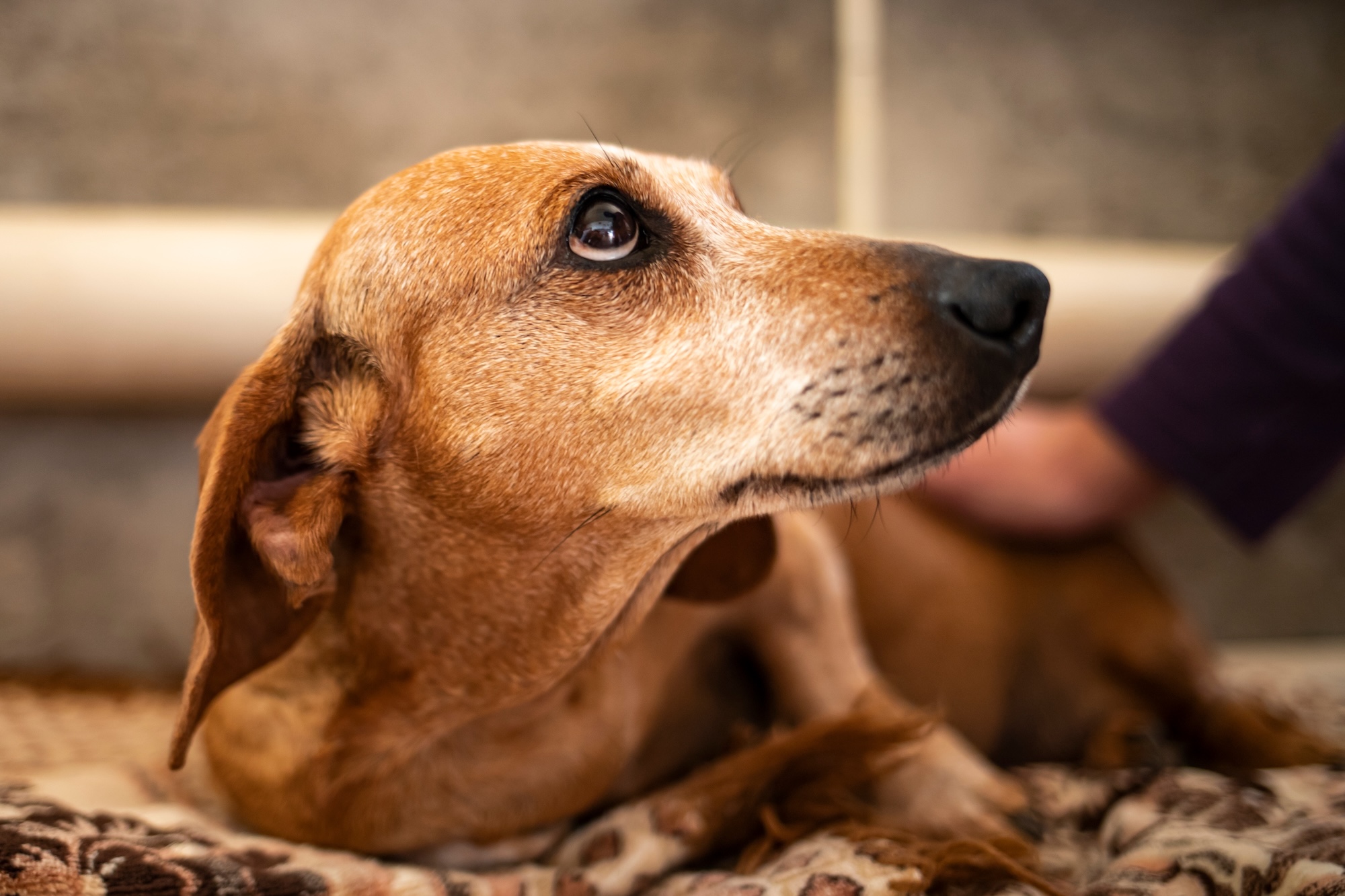Farts are funny. Until they’re not.
Canine flatulence, or gas, is something most pet owners have experienced at one time or another. And while dog owners may find this foul-smelling intrusion merely annoying, or comical, there are times when it may signify that something’s off with your dog’s health.
“Passing gas can be a normal physiologic occurrence in both cats and dogs,” says Martha Cline, DVM, and a board-certified veterinary nutritionist at Red Bank Veterinary Hospitals in New Jersey. “Generally, it can be a problem when a pet experiences excessive volume, unpleasant odor, or when it is associated with another clinical sign—like diarrhea, abdominal pain or distension.”
Something as seemingly simple as gas in dogs actually has multiple potential causes. Most are benign, but some are a cause for concern.
First, a few facts on flatulence
Flatulence results from an excess of gas in the intestinal tract. These gases may be a result of air being swallowed while eating, gas produced during digestion, or gas produced by bacteria in the colon. The really stinky gases are produced by bacteria in the colon (large intestine). The less digestible the diet, the more food residue reaches the colon to be fermented by the colon’s bacteria.
Pardon me, do you know your gases?
Flatus is expulsion of gas through the backside (that’s a fart to you and me).
That rumbling and grumbling sound in the intestines that can be heard across the room is called “borborygmus.”
Belching is the audible expulsion of gas from the stomach through the mouth.
Causes of Canine Gas
Diet: Food can have a lot to do with why your dog has chronic gas. Managing flatulence has to do with decreasing intestinal gas produced by bacterial fermentation of undigested food. This means, in a nutshell, feeding high-quality food without a lot of poorly digestible carbohydrates or proteins.
Food changes: If you think your dog’s gas is related to diet, resist the urge to make changes too quickly. “When an owner changes a diet, it needs to happen slowly to prevent diarrhea or gas,” says Jim D. Carlson, DVM, holistic veterinarian, and owner of Riverside Animal Clinic and Holistic Center in Illinois.
For adult dogs, plan to slowly transition your dog to new food over about seven to 10 days, changing the ratio in favor of the new food in small increments. Keep an eye on how sensitive your dog is to the change and adjusting the transition time accordingly.
Dumpster Diving: Beyond what pet owners are knowingly feeding, we can’t ignore the stolen treats and extras—including those found in the trash. “Most dogs I see have diet-related gas ailments in which they have eaten inappropriate food from the trash, the table, or a loving pet owner who decided to share the holiday food,” says Dr. Carlson.
If you have a dumpster-diving pup, consider investing in secure, lidded trash cans and food containers with lids you can latch closed. Latches on kitchen cabinets and refrigerators may also help for those particularly determined dogs. Think: child-proofing. During walks, make sure you’re using your own spider senses to scan for “street treats” on the ground, and steer your dog away.
Aerophagia: The act of swallowing too much air, or aerophagia, is another possible cause of canine gas. Dogs who eat or drink too quickly may swallow a surprising amount of air, and if not burped out, it will have to come out the other end. Brachycephalic breeds like French Bulldogs are prone to swallow more air due to their conformation (they breathe more through the mouth rather than the nose). For dogs who are eating or drinking too quickly, slow-feed dishes that have raised centers, or food puzzles, can help slow them down by reducing the amount of food or water they can ingest at once. You can also try dividing your dog’s food into smaller portions and serve these in multiple feedings throughout the day.
Allergies: Dogs may have food allergies or sensitivities that can lead to problems with diarrhea, vomiting and gas. Other allergy-related issues pet owners may see along with digestive issues are itching, hives, hair loss, facial swelling, and chronic ear and paw infections.
Once you determine the food ingredient your dog is sensitive to, your veterinarian will most likely recommend avoiding it in your pet’s diet.
Medical conditions: Intestinal parasites, colitis, inflammatory bowel disease (IBD), gastrointestinal cancer like lymphoma, exocrine pancreatic insufficiency (EPI) and pancreatitis are all medical conditions in dogs that may lead to gas.
Inflammatory bowel disease (IBD) and colitis are gastrointestinal disorders associated with chronic inflammation of the stomach, small intestine and/or colon and of unknown cause. The lining of the gastrointestinal tract is inflamed, causing diarrhea, vomiting, anorexia and weight loss with disruption in nutrient digestion.
EPI means that dogs can’t make the pancreatic enzymes necessary to digest fats, carbohydrates and proteins, often leading to unexplained weight loss. Gas may also result as a symptom due to increased amounts of undigested foods reaching the colon and gas-producing bacteria.
Pancreatitis is inflammation of the pancreas and can cause vomiting, pain in the abdomen, diarrhea, loss of appetite and gas.
Many intestinal parasites (aka worms) like roundworms cause digestive issues, including gas, in dogs. There are also several types of gastrointestinal tumors that can affect dogs. Symptoms can include vomiting, diarrhea, and gas. Viral enteritis, gastrointestinal cancers and small intestinal bacterial overgrowth can also be associated with excess gas.
“In my practice as a veterinary nutritionist I mostly see gas associated with primary gastrointestinal diseases like IBD, food intolerance or hypersensitivity, and colitis,” says Dr. Cline. “If your pet is uncomfortable or experiencing any other clinical signs associated with their gas, or if you are concerned for any reason, this is a good reason to have your pet checked out by a veterinarian.”
Occasional gas can be healthy, says Dr. Carlson, “but too much is typically associated with foul smell, vomiting and diarrhea associated with viral enteritis, maldigestion/malabsorption, irritable bowel disease, small intestinal bacterial overgrowth, colitis, and cancer.”
Constipation: Dr. Carlson points to another condition that can contribute to a gas problem: Back or hip problems may lead to constipation, which may in turn lead to gas.
“When I’m looking at a dog who is really gassy, I have to first consider constipation and why that could be,” Dr. Carlson says. “It’s surprising how many dogs I see who, upon diagnostic imaging, show some back or hip issue. When structural pain occurs, some dogs can’t squat or fully eliminate. Soon, stool builds up and so do large gas bubbles that run past the stool.” The increased time the stool remains in the colon and rectum will allow bacteria that normally live there to act on the stool, causing putrefaction and excessive gas production.
Dr Carlson recommends observing your dog when they’re getting ready to go. Are they able to position themselves easily for the process? If they seem uncomfortable, consider bringing it up with your veterinarian.
When to worry
There’s a wide range of causes of gas. So, when does it merit a trip to the vet?
“Normal gas is occasional and shows no signs of being anything out of the ordinary,” says Dr. Carlson. Any sign of pain along with gas can indicate a few serious causes, such as a foreign body obstruction or bowel torsion. “When it’s painful, it’s an emergency,” Dr. Carlson says. Pain symptoms in dogs can range from lethargy and hiding to whimpering or wailing.
He adds that if you notice excessive, odorous gas accompanied by vomiting and/or diarrhea, you should contact your veterinarian. Chronic or a sudden increase in gas also warrants a vet visit.
It’s also important to keep an eye on your pet’s stool. “Normal stools in your pet appear firm but not hard; they’re segmented in appearance with little or no residue remaining when picked up,” says Dr. Cline.
How to reduce your dog’s gas
High-quality, fresh food will go a long way in keeping your dog’s digestive system working properly. Changing to a minimally processed and highly digestible diet is one effective way to combat gas.
Here are some other ways you can decrease your dog’s gas output:
· Discourage rapid eating by using slow-feeding bowls or food puzzles. This prevents your dog from taking such large mouthfuls.
· Avoid treats containing milk, cheese or other forms of lactose.
· Encourage regular exercise as this keeps intestinal gases moving and prevents intestinal gasses from pooling/building up.
· If possible, walk your dog within 30 minutes of eating to encourage passing gases outside!
This article was vetted by vets.
Reviewed by Alex Schechter, DVM, and founding veterinarian at Burrwood Veterinary. He was previously founding veterinarian at Pure Paws Veterinary Care;
Danielle Woolf, DVM.




